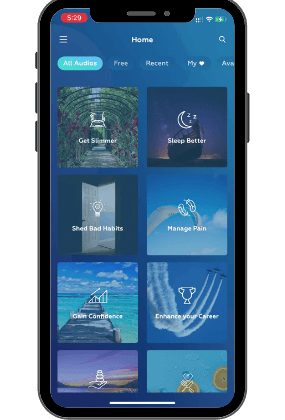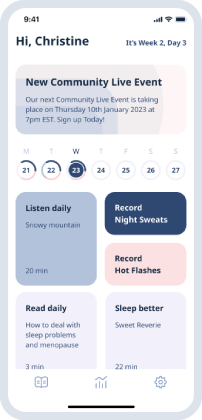
Hypnotherapy: What is It? How Does it Work?

What is Mind-Body Medicine?
Table of Contents
Only some people had access to a trained hypnotherapist. And among the ones with access to professional help, affordability might be an issue. This article tackles a very effective way to manage your mental and physical health and achieve peak performance. It is called self-hypnosis.
What is Self-Hypnosis?
Self-hypnosis is a highly focused state of awareness where distractions fade away. In the hypnotic state, you can unlearn the wrong useless behaviours and learn better behaviours.
With the increasing scientific evidence about the efficacy of hypnotherapy and self-hypnosis for various ailments, more and more people are turning to this self-management tool. Over the last decade, more research has sought to identify new applications for hypnosis.
In the hypnotic state, the subconscious mind can readily accept suggestions and help you reframe experiences. For example, you can become more aware of your strengths and progress in learning new skills, increasing your self-confidence.
Hetero-Hypnosis vs Self-Hypnosis
Hetero-hypnosis refers to the case of hypnosis facilitated by a third person, a hypnotherapist. In contrast, self-hypnosis refers to the process by which a person induces hypnosis on their own. It is said that every hetero-hypnosis involves self-hypnosis because the hypnotherapist guides the patient into that resourceful state.
Here are a few differences between a clinical hypnosis intervention and a self-hypnosis session:
During the clinical hypnosis intervention, the therapist will take your history and record your specific goal. With self-hypnosis, you naturally skip that stage. Instead, you can dive directly into change work and make the most of the few moments available for your practice.
A hypnotherapy treatment is fast, but it still requires a few sessions. However, a person who practices self-hypnosis can utilize the hypnotic techniques anytime and anywhere.
The Power of Hypnotic Suggestions
We already established that the hypnotic state can help you reframe thoughts and, as a result, learn better behaviors. Therefore, you can think of hypnotic techniques as a gateway to that resourceful state. In that state, you need to use well-crafted suggestions. They are typically drafted in the present tense and facilitate ego strengthening. In other words, they increase your adaptability, resourcefulness and self-esteem.
Mental Imagery
Self-hypnosis involves imagery. We all can imagine things. Ernest Hilgard, a psychologist and professor at Stanford University, did extensive research on hypnosis in the 1950s. In addition to creating the Stanford Hypnotic Susceptibility Scale, he coined the phrase “believed-in imagination” to describe hypnosis.
Many high performers used the power of imagery for sports or public speaking. For example, athletes often rehearse a game in their head while using positive self-talk. It is worth noting that imagery is a multi-sensory experience which employs more than the visual modality. It can include kinaesthetic, olfactory, and auditory elements.
Post-Hypnotic Suggestions
Post-hypnotic suggestions are a particular type of suggestion focusing on what may happen after the session. They allow you to imagine a better outcome. Post-hypnotic suggestions are beneficial because they help you regain control during and after the session.

What Can the Hypnotic State Do for Me?
Many leading medical and psychological associations endorse hypnosis to alleviate anxiety and stress, improve sleep quality, and manage hot flashes in menopausal women. Hypnosis can also help you shed extra pounds and increase your confidence.
Access Professional Help
Many do not live close to a trained hypnotherapist. As a result, having only one hypnosis session can be difficult and impractical.
Smoking Cessation with Self-Hypnosis
Lungs perform an essential function. They bring oxygen to the blood circulatory system. But smoking or vaping inflicts direct damage on the lungs. The inhaled chemicals can spread in the body and negatively impact the heart and nearly every organ in the body, including the reproductive organs, bones, eyes, mouth, digestive organs, and bladder.
According to a study, people who engaged in imagery and listened to a daily 20-minute tape were more than twice more likely to abstain at the 2-year follow-up compared with the control group, which only received counseling sessions and education.
Hypnosis has a long history as an aid capable of helping people stop smoking.
Alleviating Sleep Disturbances
Sleep is paramount. A person cannot skip rest without severe consequences for their health. A night of good sleep improves the mood, dampens appetite, and increases focus. But too many factors can reduce its quality: poor lifestyle habits like drinking or overeating in the evening can make sleep more shallow. In addition, overthinking may prevent the natural sequence of events until eye closure. Unprocessed grief is also a reason for poor sleep.
Because the reasons for poor sleep can vary, self-hypnosis can be an excellent management tool. Sometimes, we are caught off-guard, travelling to an unfamiliar place or needing more time to pause. And yet, moments when stress piles up or we have to deal with a setback require extra help. Practising self-hypnosis in those times can positively impact one’s life, helping one fall asleep and stay asleep longer.
Self Improvement
Self-confidence is the first step to success. Without self-esteem, there is no striving for a particular goal. A lack of confidence reduces one’s ability to withstand stress and seek novelty.
Where does our confidence come from?
The series of past experiences and conclusions we draw from them are all stored in our subconscious mind. These meanings form the blueprint of our decisions, and the only way to change our behaviour to novelty is to improve the mental shortcuts we use daily.
Manage Menopause
Menopausal women may face daily hot flashes and night sweats. Not only can hypnosis manage the stress caused by menopausal symptoms, but it can also improve sleep. Many studies point to the efficacy of self-hypnosis treatments for women in menopause.
These studies show that self-hypnosis can reduce the frequency of hot flashes and their overall scores.
Achieve Weight Loss
Being overweight brings many issues, which can increase emotional eating. For example, a person who lacks self-esteem because of their appearance may eat more unhealthy foods and put on weight. In addition, poor sleep might increase their hunger, leading to extra weight, lack of confidence and more inadequate sleep.
Having only three healthy meals a day may prove impossible for some. Hypnosis can help address the triggers behind the urges to eat and improve sleep and confidence.
Improve Physical Health & Manage Pain
Many studies show hypnosis can help treat irritable bowel syndrome and reduce nausea. Hypnotherapy can also reduce physical pain in a non-invasive and safe manner.
This technique is used in many European hospitals for selected surgeries and interventions. Hypnosis allows the staff to administer fewer medications and improve the level of care. Many specialists’ testimonials also point to the benefits of hypnosis on the medical staff working in emergency departments. They enjoy more calm.

Examples of Self-Hypnosis Techniques
There are many ways to achieve self-hypnosis. All the methods have one point in common: focus. They all help you focus on one element of your experience:
- A spot in front of you
- Your breath
- A sound
- A sensation
- A fragrance
- A particular mental imagery
Is Self-Hypnosis Relaxation?
Self-hypnosis is not relaxation. While hypnosis is often achieved in therapeutic settings through relaxation, it does not need to integrate relaxation. Because a state of relaxation enables focus, therapists will help a patient become more relaxed at first.
Self-hypnosis sessions will include different relaxation techniques, such as progressive muscle relaxation or abdominal breathing. By breathing slowly, you can deepen the hypnotic state.
How to Hypnotize Yourself
You first need to make your environment favorable for a self-hypnosis session. Here is a brief checklist:
- Choose a quiet room
- Select a comfortable chair
- Switch off any electronics, including your phone
- Avoid tight clothing and choose comfortable clothing instead
- Continue breathing slowly to enter a relaxed state of focus
You can then start listening to your hypnosis audio. Your hypnotherapist guides you through soothing instructions.
It would be best if you aimed to use self-hypnosis at least once daily. In the first week or so, we encourage people to practice self-hypnosis techniques twice or even three times a day. Not only will you be learning excellent skills, but you can also relax deeply.

How Can I Learn Self Hypnosis?
Self-hypnosis is a natural state. So achieving it is relatively easy but knowing what to do in that state is where the skill of a hypnotherapist comes into play.
Many self-hypnosis trainings will focus on one technique or application, but you might need other methods for different ailments.
A hypnosis app provides the necessary guidance as you learn how to become more relaxed and engage in therapeutic reverie. The application’s program constitutes a self-hypnosis training which helps make the most of its therapeutic benefits.
Tips to Best Practice Self-Hypnosis
Apart from ensuring the best environment possible, here are two things to keep in mind.
Self-hypnosis requires practice. Give yourself the time to master these techniques. Do not expect a linear progression. It is not unusual to see patients report substantial gains after a tepid start. There are able able to enter a relaxed state faster and imagine better outcomes.
Do not seek to deepen your hypnotic state right away. Self-hypnosis happens naturally, so you do not have to force it. As you keep using self-hypnosis daily, you will likely achieve more significant depths of focused awareness. With continued practice, you can reach a deeper level of relaxation. It will become easier to enjoy hypnosis, the same way regular exercise develops your muscles.
Guided Self Hypnosis through the UpNow Hypnosis App
Your days are already packed with many responsibilities. At UpNow, we made self-hypnosis easy, using various techniques for more effective and enjoyable sessions. In addition, more research is shedding light on the potential of hypnosis to provide safe and non-invasive solutions.
Regardless of the nature of your goals, from weight loss to improved sleep and a more remarkable ability to relax, hypnosis can help you enjoy a healthier and happier life.
Get ready to enjoy more calmness in your life! The more in control you become of your thoughts and emotions, the more calm you can enjoy. So download the UpNow app today and start practicing self-hypnosis!
FAQs
Autogenic training uses self-hypnosis training to induce a deep state of relaxation. The word “autogenic” means “coming from within.” German psychiatrist Johannes Heinrich created this technique.
No, self-hypnosis is not meditation. While the hypnotic state can be very relaxing and feel like a meditative state, what sets self-hypnosis apart is the range of applications in peak performance and physical and mental health.
Hypnosis has helped many reduce stress before medical interventions, exams or competitions. The American Psychological Association lists the reduction of stress and anxiety as two hypnotherapy applications.
No hypnosis is different from relaxation. You can achieve this state without being relaxed. This being said, becoming relaxed makes it easier to enter hypnosis.
UpNow Health only uses high-quality sources, including peer-reviewed articles, to support the facts within our articles. In addition, all our articles are reviewed by experts to ensure that our content is accurate, helpful, and trustworthy.
1. Tod, D., Hardy, J., & Oliver, J. (2011). Effects of self-talk: A systematic review. Journal of Sport & Exercise Psychology, 33, 666–687.
2. Cumming, J., & Williams, S. E. (2012). The role of imagery in performance. In S. Murphy (Ed.), Handbook of sport and performance psychology (pp. 213–232). New York: Oxford University Press.
3. McCullagh, P., Law, B., & Ste-Marie, D. M. (2012).Modeling and performance. In S. Murphy (Ed.), Handbook of sport and performance psychology (pp. 250–272). New York: Oxford University Press.
4. Chamine, I., Atchley, R., & Oken, B. S. (2018). Hypnosis Intervention Effects on Sleep Outcomes: A Systematic Review. Journal of clinical sleep medicine : JCSM : official publication of the American Academy of Sleep Medicine, 14(2), 271–283. https://doi.org/10.5664/jcsm.6952 Accessed 10th February 2022
5. Donald Moss (2022) Using guided imagery and hypnosis in brief therapy and palliative care, American Journal of Clinical Hypnosis, 64:4, 384-386, DOI: 10.1080/00029157.2022.2039675
6. How Smoking Affects the Heart and Blood Vessels. (2022, March 24). NHLBI, NIH. Link.
7. Wynd, C.A. (2005), Guided Health Imagery for Smoking Cessation and Long-Term Abstinence. Journal of Nursing Scholarship, 37: 245-250. https://doi.org/10.1111/j.1547-5069.2005.00042.x
8. Burte, Jan & Burte, Wayne & Araoz, Daniel. (1994). Hypnosis in the treatment of back pain. Australian Journal of Clinical Hypnotherapy and Hypnosis. 15. 93-115.
9. Nurul Afiedia Roslim, Aryati Ahmad, Mardiana Mansor, Myat Moe Thwe Aung, Farrahdilla Hamzah, Mohd Razif Shahril & Pei Lin Lua (2022) Does hypnosis result in greater weight loss compared to conventional approach?, American Journal of Clinical Hypnosis, 65:2, 99-109, DOI: 10.1080/00029157.2021.2010642
10. Gary Elkins, Aimee Johnson, William Fisher, Jim Sliwinski & Timothy Keith (2013) A Pilot Investigation of Guided Self-Hypnosis in the Treatment of Hot Flashes Among Postmenopausal Women, International Journal of Clinical and Experimental Hypnosis, 61:3, 342-350, DOI: 10.1080/00207144.2013.784112
11. Seyda Efsun Ozgunay, Burcu Dincgez, Derya Karasu, Gulten Ozgen, Ibrahim Taymur, Sermin Eminoglu & Ilkay Ceylan (2022) Adjuvant Hypnotherapy for Hyperemesis Gravidarum: A Randomized Pilot Study, International Journal of Clinical and Experimental Hypnosis, 70:3, 277-285, DOI: 10.1080/00207144.2022.2098026
12. Erika Fromm (1987) Significant Developments in Clinical Hypnosis During the Past 25 Years, International Journal of Clinical and Experimental Hypnosis, 35:4, 215-230, DOI: 10.1080/00207148708416056













